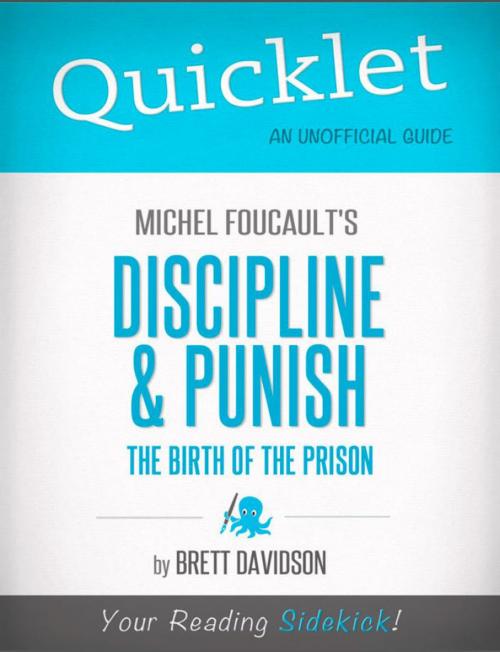Quicklet on Michel Foucault's Discipline & Punish: The Birth of the Prison (CliffNotes-like Summary)
Nonfiction, Reference & Language, Study Aids, Book Notes, Art & Architecture, General Art| Author: | Brett Davidson | ISBN: | 9781614648994 |
| Publisher: | Hyperink | Publication: | February 29, 2012 |
| Imprint: | Hyperink | Language: | English |
| Author: | Brett Davidson |
| ISBN: | 9781614648994 |
| Publisher: | Hyperink |
| Publication: | February 29, 2012 |
| Imprint: | Hyperink |
| Language: | English |
ABOUT THE BOOK
To read and understand Foucault is to know that you are not a free man, but in fact a prisoner/guard in a penitentiary named Western Society. Discipline and Punish changed the way the humanities and social sciences understood power and the way that I understood my place in the world. It answers questions like why non-conformists dress like all the other non-conformists and why we all try to hide the fact that we are singing to ourselves in our cars while simultaneously watching other people to see if they are singing to themselves.
We all participate in maintaining the norms and rules of our society. In the Rebellious sixties, young people were attacking the establishment but they did not realize how deeply entrenched the power was and how it flowed, not from the top down, but out of all levels of society as a ubiquitous force.
MEET THE AUTHOR
Davidson received his BA from the University of Windsor and his MA from Carleton Universitity. He teaches history at Eldercollege in Windsor, Ontario and has published a biography of Charles G.D. Roberts. You can follow his blog at www.hubpages.com/bkeithdavidson.
EXCERPT FROM THE BOOK
Part one “Torture” begins with the gruesome execution of convicted regicide Robert-Francois Damiens who had attempted to murder Louis XIV and had his sins cleansed by making Amene Honorable. The rest of the book then has to explain how we have moved in only two hundred years from burning hot pincers removing the flesh from your bones to sitting in prison with three meals a day. The societal pressure for the move towards lenience began only decades after the grizzly death of Damiens and came from all levels of society. This period saw the focus of judicial punishment shift from the body to the soul. To use Foucault’s phrase, “The soul is the prison of the body.”
The theatrical displays that accompanied of the earlier forms of punishment are now reserved for the court room. The second part “Punishment” starts with a discussion of the reform movement of the late eighteenth century that forced sovereigns and governments in general distance themselves from the violent act of killing. Judgement was put on display and punishment was hidden away. While capital punishment still exists, it is now done clinically and behind closed doors. Society itself was changing. There was a shift away from violent crimes into property related crimes. It is important to note that while many of the middle class philosophers were writing about this problem the demand for change came from all levels of the society. The lower classes were becoming more sympathetic to the plight of the condemned and even tried to help them at times.
“Discipline” is the third part of the book and it deals with the training of the soul so that the society can exert power over it. This section deals with taking the human in any form and moulding it into the desired form. Foucault uses the example of the soldier and how this used to be a position that a man had to fit before he could join an army. Foucault saw a shift in the eighteenth century whereby armies started to believe that they could make soldiers out of any man no matter his condition. This philosophy extends into the society as school, hospital, and prison all have their methods, tests, and drills designed to create the model citizen. This section also explores how these institutions use the “political technology of the body” to control the space and time of the individual to create proper behaviour. Schedules and time tables are used to control the mind and organize the body.
Buy a copy to keep reading!
ABOUT THE BOOK
To read and understand Foucault is to know that you are not a free man, but in fact a prisoner/guard in a penitentiary named Western Society. Discipline and Punish changed the way the humanities and social sciences understood power and the way that I understood my place in the world. It answers questions like why non-conformists dress like all the other non-conformists and why we all try to hide the fact that we are singing to ourselves in our cars while simultaneously watching other people to see if they are singing to themselves.
We all participate in maintaining the norms and rules of our society. In the Rebellious sixties, young people were attacking the establishment but they did not realize how deeply entrenched the power was and how it flowed, not from the top down, but out of all levels of society as a ubiquitous force.
MEET THE AUTHOR
Davidson received his BA from the University of Windsor and his MA from Carleton Universitity. He teaches history at Eldercollege in Windsor, Ontario and has published a biography of Charles G.D. Roberts. You can follow his blog at www.hubpages.com/bkeithdavidson.
EXCERPT FROM THE BOOK
Part one “Torture” begins with the gruesome execution of convicted regicide Robert-Francois Damiens who had attempted to murder Louis XIV and had his sins cleansed by making Amene Honorable. The rest of the book then has to explain how we have moved in only two hundred years from burning hot pincers removing the flesh from your bones to sitting in prison with three meals a day. The societal pressure for the move towards lenience began only decades after the grizzly death of Damiens and came from all levels of society. This period saw the focus of judicial punishment shift from the body to the soul. To use Foucault’s phrase, “The soul is the prison of the body.”
The theatrical displays that accompanied of the earlier forms of punishment are now reserved for the court room. The second part “Punishment” starts with a discussion of the reform movement of the late eighteenth century that forced sovereigns and governments in general distance themselves from the violent act of killing. Judgement was put on display and punishment was hidden away. While capital punishment still exists, it is now done clinically and behind closed doors. Society itself was changing. There was a shift away from violent crimes into property related crimes. It is important to note that while many of the middle class philosophers were writing about this problem the demand for change came from all levels of the society. The lower classes were becoming more sympathetic to the plight of the condemned and even tried to help them at times.
“Discipline” is the third part of the book and it deals with the training of the soul so that the society can exert power over it. This section deals with taking the human in any form and moulding it into the desired form. Foucault uses the example of the soldier and how this used to be a position that a man had to fit before he could join an army. Foucault saw a shift in the eighteenth century whereby armies started to believe that they could make soldiers out of any man no matter his condition. This philosophy extends into the society as school, hospital, and prison all have their methods, tests, and drills designed to create the model citizen. This section also explores how these institutions use the “political technology of the body” to control the space and time of the individual to create proper behaviour. Schedules and time tables are used to control the mind and organize the body.
Buy a copy to keep reading!















